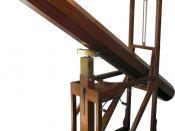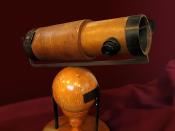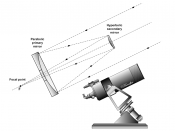Reflecting telescopes are the other type of optical telescope. Sir Isaac Newton made the first reflecting telescope in 1668. There are two main designs of reflecting telescopes, the Newtonian design and the Cassegrain design. In the Newtonian design, a concave mirror reflects the light from the sky to a flat, smaller mirror (or sometimes prism), that diverts the light to an eyepiece located on the side of the tube. In the Cassegrain design the light reflects back through a small hole that is cute in the centre of the main mirror. The second mirror blocks a bit of the light that is coming from the main mirror, but it does not affect the image. One good thing about reflectors is that large mirrors can be made easier and cheaper than large lenses. The largest modern telescope are reflectors.
William Herschel, an English observer, discovered the planet Uranus in 1781 with his large reflector telescope.
He also discovered many nebulae and star clusters. In 1845, with the use of reflector telescopes, it was discovered that nebulae were spiral in shape. This was the beginning of the discovery that these objects were in fact galaxies, outside of the Milky Way.
One of the world's largest reflectors is the "200 inch" Hale telescope at California's Mount Palomar. You can view objects billions of light-years away!



Well-written
this is well-written, a it short though. But it is good enough for the novices on telescopes.
0 out of 1 people found this comment useful.